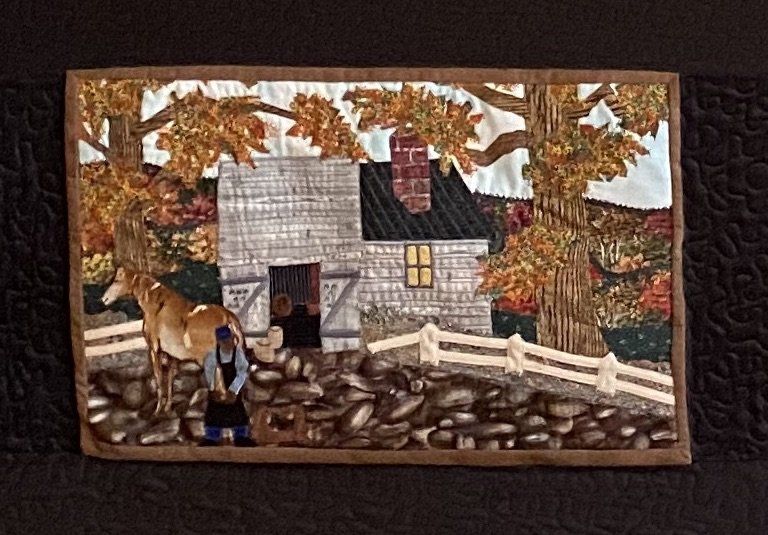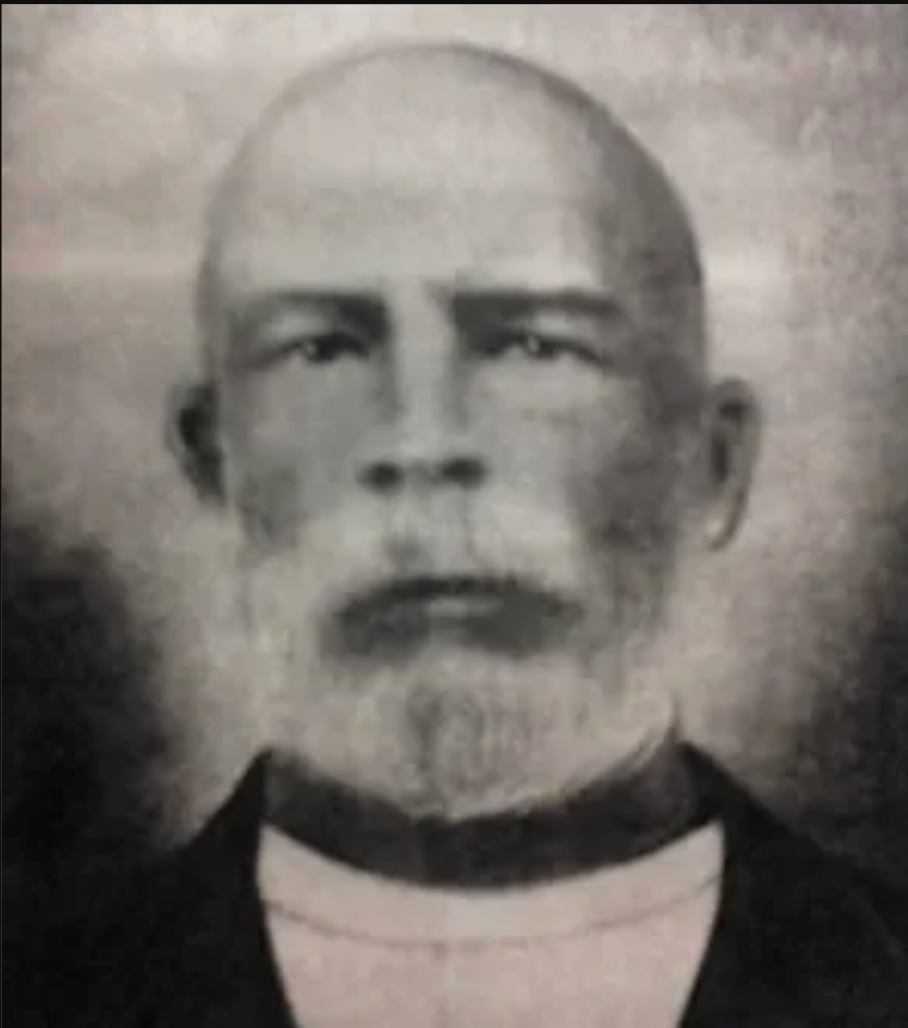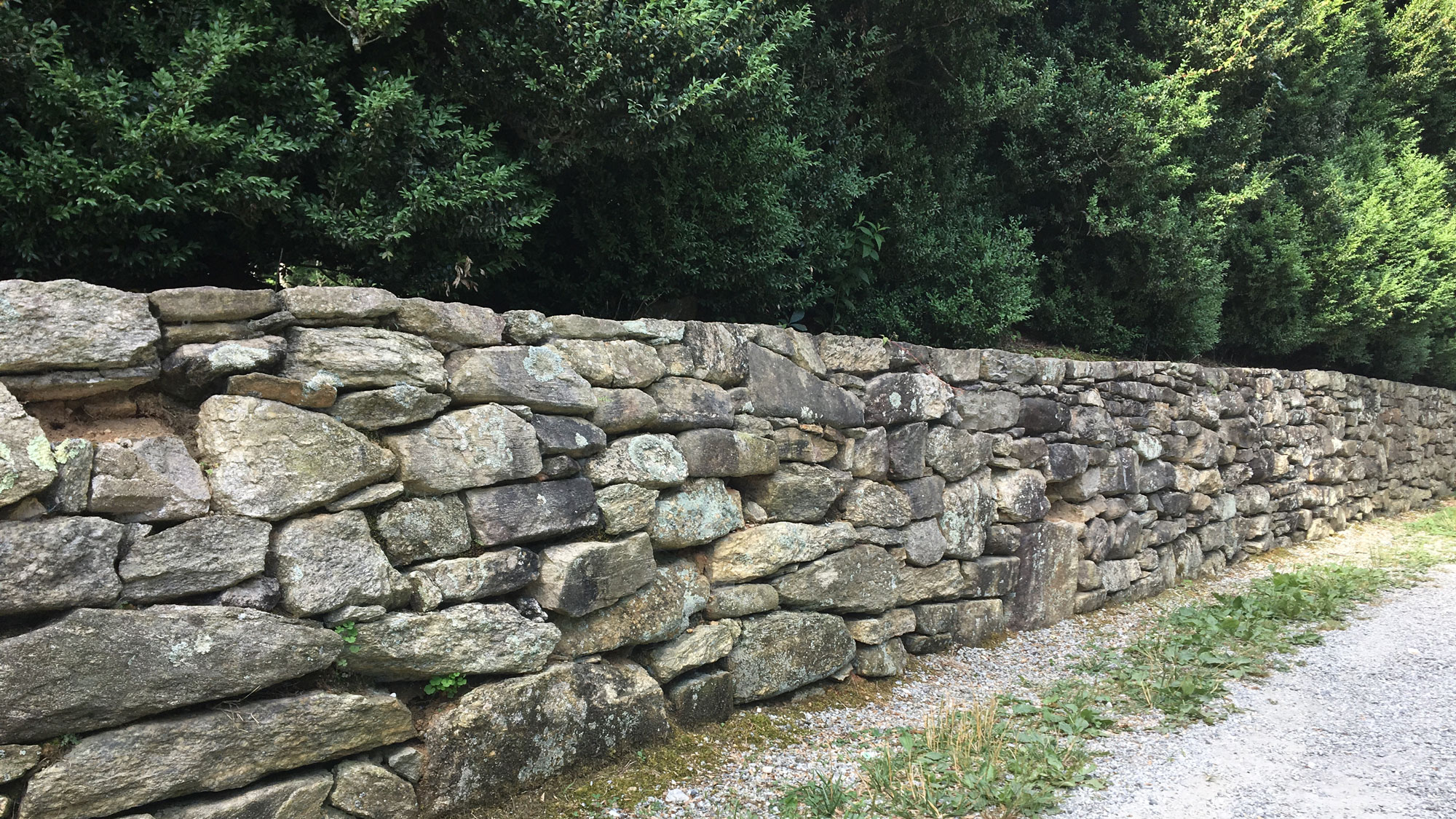Forging Their Place in Flat Rock History
/Panel from Quilt hangin in Flat Rock Village Hall depicting the Markley Blacksmith Shop
Hanging in a conference room of Village Hall is a quilt depicting several prominent people and places that help define the long and storied history of Flat Rock. One of the panels of that quilt depicts a blacksmith shoeing a horse in front of his modest wooden shop. Noted Flat Rock historian, Louise Howe Bailey wrote a description of each panel of the quilt, and regarding the blacksmith, she wrote:
A popular gathering place for the lads of Flat Rock was Markley’s Blacksmith Shop, founded by John Markley and continued by his sons James and Garfield. A highlight of summer was rounding up all of the horses and taking them to be shod. Fascination lay not only in the strength and skill of the blacksmiths but in their homespun philosophy that made its point through tales told by the Markleys for both entertainment and example. (1)
The site of the Markley Blacksmith Shop was of such significance that Historic Flat Rock, Inc. erected a marker commemorating the location in 2013 on West Blue Ridge Road where the shop once stood. Years later, another famous local historian, Terry Ruscin, would write about the Markley’s shop in his column, Beyond the Banks printed by the Hendersonville Citizen-Times:
Alongside Blue Ridge Road there once stood a historic marker commemorating a former enterprise that operated from that site for several decades. The plaque’s inscription read: “Site of Markley Blacksmith Shop • 1848 to 1960 • Artisans of Malleable Metals.” (2)
Today, the building which housed the Markelys’ business is gone and the historic marker has been removed as well. Still, the legacy of the small blacksmith shop started by John Markley endures and is recounted here through extracts of various accounts and articles written about the Markley family through the years.
—
Who was John Markley?
John Calhoun Markley. Courtesy of Al Creasman.
Terry Ruscin wrote possibly the most definitive account of the Markley family and their enterprise in an April 12, 2021 edition of his column printed by Hendersonville Times-News. About the patriarch of the Markley family, he wrote the following:
John Calhoun Markley (1848-1921), a popular blacksmith and wheelwright in Flat Rock, was the son of Carolina King and the stepson of Henry King.
According to extensive research conducted by Markley family descendants, John’s biological father was Valentine Ripley (1807-1879), one of Hendersonville’s earliest entrepreneurs. Ripley purportedly taught the trade of blacksmithing to his son, John C. Markley.
Ripley’s prominence impacted Hendersonville’s early commercial development. He owned a stagecoach line and an early hotel in Hendersonville. Two of his commercial buildings still stand on Main Street. He was a member of the State Assembly and built Hendersonville’s Judson College. He also served as justice of the peace.
Ripley owned 52 slaves, per the 1860 U.S. Census Slave Schedule (Henderson County 207). Ripley’s illegitimate son John took the name “Markley” as the Ripley family wanted to eschew any possible embarrassment. John’s mother, Carolina, (was) counted among Ripley’s slaves. (2)
As the mixed-race son of a prominent white slaveholder, John may have had more opportunities and connections with prominent local citizens to help build a career as an independent businessman in the post-Civil War Flat Rock. Frank Fitzsimons observed in his book, From the Banks of the Oklawaha:
John began blacksmithing as a child because smithing was “...an occupation that was taught to all Markley men.” John Markley worked as a blacksmith for Dr. Mitchell C. King at Glen Roy and as a craftsman and blacksmith for Henry T. Farmer, owner of the Farmer Hotel (now Mansouri Mansion), before opening his own shop. (3)(7)
John would eventually marry Sallie (Sally) who came to be known as Aunt Sallie and lived to be 104 years old. Ruscin wrote:
Sallie Samantha Daugherty Markley (1854-1959), a renowned midwife in Flat Rock and its environs, was born to Soge (a Cherokee man from Swannanoa, c. 1830-c.1870) and Caroline Rhodes Daugherty (born circa 1842). As a youngster, Sallie lived with her grandparents Alphrad and Phyllis Rhodes.
Known fondly as “Aunt Sallie,” she married “Honest John” Calhoun Markley, the blacksmith in Flat Rock. Besides midwifery, Sallie provided laundry services and worked at Farmer’s Hotel. John and Sallie were counted among the members of Mud Creek Missionary Baptist Church at East Flat Rock.
Sadie Smathers Patton wrote that, early in their lives, John and his wife Sallie worked for Minerva Patton at her farm. John also crafted furniture at Squire Farmer’s [Squire Henry Tudor Farmer Jr. (1856-1943)] furniture factory, for Farmer’s Hotel (Woodfield Inn) in Flat Rock. (2)
SAllie Markley. courtesy of of Paula Coleman Manchen
Family names provided by Ruscin’s account concerning John and Sally diverge slightly from the account provided by Historic Flat Rock, Inc. He lists Sallie instead of Sally. Daugherty instead of Darity, and Sally’s father as Soge instead of Logan.
Jennie Giles wrote in her “Henderson Heritage” blog that the couple moved to their eventual home on West Blue Ridge from the Kingdom of the Happy Land where they and their sons operated the blacksmith shop until the early 1960s.
John C. Markley and his wife, Sally Markley, who was a famous midwife and granny doctor for many years in the community, were former slaves who moved to the community from the Kingdom of the Happy Land in the Green River community.
One of the couple’s sons was James R. Markley (1887-1965). He was one of the most famous blacksmiths in Henderson County in the first half of the 1900s, along with his brother J.G. Markley (1881-1932). (4)
Missy Schenck, President of Historic Flat Rock, Inc., also wrote about the Markleys in an article published by the Charleston Mercury and references further details:
Sally Markley was the daughter of Logan Darity, a Cherokee man abandoned as a baby on the battlefield and raised by white settlers.
John was also the first mail carrier for Flat Rock as well as a farrier, and his son Jim served after him. John operated a blacksmith shop with his two sons on West Blue Ridge Road beside King Creek. (5)
Historic Flat Rock records the Markley’s move to Flat Rock as occurring in 1877, possibly from the Patton farm in Naples North Carolina (just north of current-day Hendersonville) - although it is possible they first moved to the Kingdom of the Happy Land where many freed slaves found homes after emancipation.
Sally married John Calhoun Markley when both were working on Mrs. Minerva Patton’s farm in Naples, North Carolina. The couple moved to Flat Rock in 1877 where their first child was born. Sally and John Markley eventually had eleven children who survived to adulthood. (3)
John Markley ran his shops until his death in 1921 when his sons assumed the business:
John Markley ran the blacksmith shop with help from two of his sons, Garfield and James R., known as Jim. Jim Markley had begun smithing with his father in 1887, while still a child.
John Markley died in 1921 at the age of 73. Garfield, who also worked as a mail carrier, and Jim Markley continued the blacksmithing business and their mother Sally continued to live in their house next door.
After his brother’s death, Jim Markley operated the blacksmith shop until the mid-1960s when, because of failing health, he also moved to Washington, D.C., and lived with his sister. He died July 5, 1965. (3)
Jim Markley shoeing Lady Jane, a horse of Alice Andrews whose grandCHILDREN LOOK ON. PHOTO COURTESY OF ALICE LEE
In his 2021 article about the Markley family, Terry Ruscin relied on an account written by his friend and mentor, Louise Bailey, to paint a picture of the Markleys’ impact on the community of Flat Rock
“You have to be an old-timer to…have known the Markley family who had a blacksmith shop. Yet the Markleys were probably the busiest people in the whole community.
“Special memories still linger with Flat Rock residents who took their horses to the Markleys’ blacksmith shop, on the sharp bend of Blue Ridge Road, to be shod. When the summer season opened and families from Charleston, Savannah and New Orleans, flocked to their Flat Rock houses, work for the Markleys became so heavy that Jim, who had followed his father as the farrier, was obliged to close for two hours in the middle of the day to rest from handling impatient horses.
"Jim’s father had been the first mail carrier in Flat Rock as well as a farrier, and for a time Jim had served after him, walking effortlessly with the mail in a sack over his shoulder, for there was not a great deal of it.
“Lads took the horses to the Markleys’ shop and waited while the shoeing was going on. What they liked even better than watching Jim’s skilled hands at work were the stories he told and the special way he had of telling them. He did it in what he called ‘rabbit talk,’ strange syllables he claimed only he and the rabbits could understand. (1)
—-
As for the missing Historic Marker on the site of the Markley blacksmith shop, the original information on the marker erroneously stated that the business started in 1848 - which was John’s birth year, not when he opened his shop. Ruscin wrote in 2021:
Logic would suggest that Jim’s father, John Calhoun Markley, founder of the business, was not working metal nor shoeing horses in 1848, the year of his birth. Given the lack of records concerning the exact date of the shop’s establishment, a more plausible foundation date could have stated “circa 1880,” since John settled in Flat Rock around 1877.
A few years ago the marker vanished. My hope would be that the entity in charge of historic markers in the area removed the plaque with the intention of correcting the error in its conception date, and then reinstating the marker. (1)
In an article written in 2013 for Hendersonville Times-News, staff writer Emily Weaver summed up the Markley legacy with these words:
John Calhoun Markley was born a slave. He died a local legend. In that span of time, he broke the chains that bound the beliefs of what a freed African-American could do.
He (and his sons) are now remembered as “artisans of malleable metals” and “brilliant blacksmiths” who used (their) craft to help animals and the development of a booming seasonal resort town. (6)
Like many of the famous and prominent families in Flat Rock, the Markleys occupy an important and enduring place in village lore and their many contributions have helped forge an important part of Flat Rock’s long and diverse history.
References for this Article
(1)
A Short History of Flat Rock
Louise Howe Bailey
https://flatrocknc.govoffice3.com/index.asp?SEC=EB3DBB95-89E0-4EA6-ADB7-5CB5B7E7D504&Type=B_BASIC
(2)
Beyond the Banks:
A legacy forged in Flat Rock - Markleys blacksmith shop at heart of village
Terry Ruscin
Hendersonville Times-News
April 12, 2021
https://www.blueridgenow.com/story/news/2021/04/12/beyond-banks-legacy-forged-flat-rock-markleys-blacksmith-shop-heart-village/7106212002/
(3)
Flat Rock Historic District, Boundary Increase, Boundary Decrease, and Additional Documentation
Flat Rock, Henderson County, HN1352,
Listed 2/27/2015
https://historicflatrockinc.com/wp-content/uploads/2018/08/HN1352.pdf
(4)
Henderson Heritage .com
Jennie Giles
https://hendersonheritage.com/oakland-cemetery-mud-creek-missionary-baptist-church/
(5)
African-American history of Henderson County, Part Two
Missy Schenck
Charleston Mercury
https://www.charlestonmercury.com/single-post/african-american-history-of-henderson-county-part-two
(6)
Blacksmith Markley makes his mark
Emily Weaver
Hendersonville Times-News
Feb 17, 2013
https://www.blueridgenow.com/story/news/2013/02/17/blacksmith-markley-makes-his-mark/28302934007/
(7)
Frank L. Fitzsimons, From the Banks of the Oklawaha, Vol. 1 (Hendersonville, NC: Golden Glow Publishing Company, 1975), 320.








